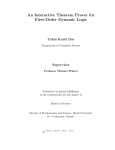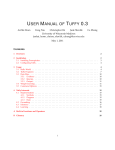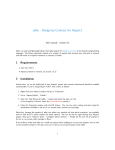Download The Alchemy System for Statistical Relational AI: User Manual
Transcript
The Alchemy System for Statistical Relational AI: User Manual Stanley Kok Parag Singla Matthew Richardson Pedro Domingos Marc Sumner Hoifung Poon Department of Computer Science and Engineering, University of Washington Aug 3, 2007 1 Introduction Welcome to the Alchemy system! This user’s manual is designed for end users wishing to perform learning and inference on Markov logic networks. It consists of the following sections: 1. Introduction 2. Installation 3. Quick Start 4. Syntax 5. Predicates and Functions The Alchemy package provides a series of algorithms for statistical relational learning and probabilistic logic inference, based on the Markov logic representation. If you are not already familiar with Markov logic, we recommend that you read the papers Markov Logic Networks [7], Discriminative Training of Markov Logic Networks [9], Learning the Structure of Markov Logic Networks [3], Memory-Efficient Inference in Relational Domains [10] and Sound and Efficient Inference with Probabilistic and Deterministic Dependencies [6] (mln.pdf, dtmln.pdf, lsmln.pdf, lazysat.pdf and mcsat.pdf in the papers/ directory) before reading this manual. We welcome your feedback on any aspect of the Alchemy package. Please email us at [email protected] to let us know what you find easy or hard to use, what results you have obtained with Alchemy, the features you wish to have but are not currently provided, and any bugs that you encounter. Please cite Kok et al. (2005) [4] if you use the Alchemy system. 1 Please be aware that this is a beta release. Some aspects of the documentation may not be as clear, and some aspects of its usage may not be as user-friendly, as you would like. We have tested the code but some bugs may inadvertently still remain. This beta release includes: • Discriminative weight learning (Voted Perceptron, Conjugate Gradient, and Newton’s Method) • Generative weight learning • Structure learning • MAP/MPE inference (including memory efficient) • MCMC inference (including memory efficient) – Gibbs sampling – MC-SAT – Simulated Tempering • Support for native and linked-in functions • Block inference and learning over variables with mutually exclusive and exhaustive values • EM (to handle ground atoms with unknown truth values during learning) In the next release we plan to include: • Specification of probabilities instead of weights for formulas in an MLN, and of probabilities for ground atoms in a database • Specification of indivisible formulas (i.e. formulas that should not be broken up into separate clauses) • More extensive documentation Alchemy uses: • C++ code from the MaxWalkSat package of Kautz et al. (1997) [2]. • C++ code from the SampleSat algorithm of Wei et al. (2004) [11]. • A port from Fortran to C++ of the L-BFGS-B package of Zhu et al. (1997) [12]. • A port from Lisp to C++ of the CNF conversion code of Russell and Norvig (2002) [8]. • The C++ code to compute the inverse cumulative standard normal distribution of Acklam (2003) [1]. • The C++ command line parsing code due to Jeff Bilmes (1992). 2 The development of Alchemy was partly funded by DARPA grant FA8750-05-2-0283 (managed by AFRL), DARPA contract NBCH-D030010 (subcontracts 02-000225 and 55000793), NSF grant IIS-0534881, ONR grants N00014-02-1-0408 and N00014-05-1-0313, a Sloan Research Fellowship, and an NSF CAREER Award (both of these to Pedro Domingos). The views and conclusions contained in this document are those of the authors and should not be interpreted as necessarily representing the official policies, either expressed or implied, of DARPA, NSF, ONR, or the United States Government. 2 Installation This release is meant for the Linux platform. If you wish to use it on Windows or OS X, you will have to make some code changes (e.g., use platform-specific C++ system calls). We compiled and tested the code using: • Fedora Core 5 • Bison 2.0 • Flex 2.5.4 • g++ 4.1.1 • Perl 5.2.1 We assume you have placed the alchemy.tgz file in the directory /home. Unzip and untar the file with the command tar xvfz alchemy.tgz. The /home/alchemy directory should be created. Henceforth we refer to /home/alchemy as ALCHDIR. In ALCHDIR/src/makefile, you should ensure that the GCC, FLEX, and BISON variables are correctly set to your g++ compiler, Flex lexical analyzer generator, and Bison parser generator, respectively. (If you do not have Flex and Bison installed on your system, you can obtain them from: http://www.gnu.org/software/flex and www.gnu.org/software/bison.) To compile the code, simply type make depend; make in the ALCHDIR/src directory. The executables will be compiled into ALCHDIR/bin. You may wish to change the BIN variable in makefile to place the compiled executables in a different directory. 3 Quick Start We provide a simple example in ALCHDIR/exdata to help you get started. Throughout the example we assume you are in that directory. For more simple examples, see the Alchemy tutorial. 3.1 Input Files Predicates and functions are declared and first-order formulas are specified in .mln files. For example, at the top of univ.mln, we declare the predicates professor, student, etc., and 3 the function motherOf as well as the types of their parameters. The first appearance of a predicate or function in a .mln file is taken to be its declaration. You can express arbitrary first-order formulas in a .mln file (more on this in Section 4). Note that a variable must begin with a lowercase character, and a constant with an uppercase one in a formula. A formula can be preceded by a weight or terminated by a period, but not both. A period signifies that a formula is “hard” (i.e., worlds that violate it should have zero or negligible probability). Types and constants are also declared in .mln files. For example, in univ-train.mln we declare the types person, title, etc., and their associated constants. Ground atoms are defined in .db (database) files. Ground atoms preceded by ! (e.g., !professor(Bart)) are false, by ? are unknown, and by neither are true. If the closed-world assumption is made for a predicate, its ground atoms that are not defined in a .db file are false, while if the open world assumption is made, its undefined ground atoms are unknown. In univ-train.db, we specified all the true ground atoms of the predicates professor, student, etc. Function mappings are defined in the .db file, as well. Linked-in functions and predicates are defined in a separate C++ file. An example file, functions.cpp is supplied. There are certain guidelines which must be followed when defining linked-in functions. This is discussed in Section 5. 3.2 Weight Learning To learn the weights of formulas, run the learnwts executable, e.g., ALCHDIR/bin/learnwts -g -i univ.mln -o univ-out.mln -t univ-train.db. -g specifies that generative learning is to be used. Alternatively, you can use -d for discriminative learning, e.g., ALCHDIR/bin/learnwts -d -i univ.mln -o univ-out.mln -t univ-train.db -ne advisedBy,student,professor. -i and -o specify the input and output .mln files as univ.mln and univ-out.mln respectively. If neither -g nor -d are specified, then discriminative learning is performed. -t specifies the .db file that is to be used by weight learning. You can specify more than one .db file after -t in a comma separated list (e.g., -t univ1.db,univ2.db). The universe of constants are those that appear in the .db files. By default, all the constants are assumed to belong to one database. If this is not the case, you can use the option -multipleDatabases to specify that the constants in each .db file belong to a separate database, and should not be mixed with those in other .db files (e.g, -t ai.db,graphics.db,systems.db -multipleDatabases). In the current version of Alchemy .db files that are used for learning can only contain true or false atoms (no unknowns). If there are constants that do not appear in the .db files, you can specify one or more .mln files containing the missing constants, and append them after the input .mln file, e.g., -i univ.mln,univ-train.mln. (You may wish to specify the extra .mln files when there are constants that only appear in false ground atoms of a closed-world predicate, or only in unknown ground atoms of an open world predicate. Such ground atoms need not be defined in .db files.) By default, unit clauses for all predicates are added to the MLN during weight learning. (You can change this with the -noAddUnitClauses option.) The -ne option is used to specify non-evidence predicates. For discriminative learning, 4 at least one non-evidence predicate must be specified. For generative learning, the specified predicates are included in the (weighted) pseudo-log-likelihood computation; if none are specified, all are included. During weight learning, each formula is converted to conjunctive normal form (CNF), and a weight is learned for each of its clauses. If a formula is preceded by a weight in the input .mln file, the weight is divided equally among the formula’s clauses. The weight of a clause is used as the mean of a Gaussian prior for the learned weight. If a formula is terminated by a period (i.e., the formula is a hard one), each of the clauses in its CNF is given a prior weight that is twice the maximum of the soft clause weights. If neither a weight nor a period is specified, a default prior weight is used for each of the formula’s clauses; you can specify a default with the -priorMean option. If a unit formula contains variables that are followed by the ! operator, the code automatically creates formulas stating that the variables have mutually exclusive and exhaustive values (see Section 4). The default prior weight for each clause in the CNF of those formulas is 1.5 times the maximum of the soft clause weights. (See the developer’s manual on how to change the default prior weights.) When multiple databases are used, the CNF of a formula with existentially quantified variables or variables with mutually exclusive and exhaustive values may be different across the databases. This occurs because we have to ground the variables to constants that are different across the databases. When this happens, we learn a weight for the formula rather than for each clause in its CNF. You can view all the options by typing ALCHDIR/bin/learnwts without any parameters. After weight learning, the output .mln file contains the weights of the original formulas (commented out), as well as those of its derived clauses. 3.3 Structure Learning To learn the structure (clauses and weights) of an MLN generatively, you use the learnstruct executable, e.g., ALCHDIR/bin/learnstruct -i univ-empty.mln -o univ-empty-out.mln -t univ-train.db -penalty 0.5. learnstruct uses beam search to find new clauses to add to an MLN. It can start from both empty and non-empty MLNs. When it starts from a non-empty MLN, it does not modify clauses that are derived from existentially quantified formulas or those containing variables with mutually exclusive and exhaustive values. Its options are similar to those of learnwts. In addition, it has options for controlling techniques that speed up the search. You can also restrict the types of clauses created during structure learning (see the developer’s manual). Type ALCHDIR/bin/learnstruct without any parameters to view all options. 3.4 Inference To perform inference, run the infer executable, e.g., ALCHDIR/bin/infer -i univ-out.mln -e univ-test.db -r univ.results -q advisedBy,student,professor -c -p -mcmcMaxSteps 20000. 5 -i specifies the input .mln file. In that file all formulas must be preceded by a weight or terminated by a period (but not both). An exception is a unit formula with variables followed by the ! operator. Such a unit formula can be preceded by a weight, or terminated by a period, or neither. (For such a unit formula, the code automatically creates formulas stating that the variables have mutually exclusive and exhaustive values. See Section 4.) Each formula in the input .mln file is converted to CNF. If a weight precedes the formula, it is divided equally among its CNF clauses. If the formula is terminated by a period (i.e., the formula is hard), each of its CNF clauses is given a default weight that is twice the maximum soft clause weight. If neither weight nor period is specified for a unit formula with variables followed by !, each of its CNF clauses is given a default weight that is 1.5 times the maximum soft clause weight. (See the developer’s manual on how to change the default weights.) -e specifies the evidence .db file; a comma-separated list can be used to specify more than one .db file. -r specifies the output file which contains the inference results. -q specifies the query predicates. You can specify more than one query predicate, and restrict the query to particular groundings, e.g., -q advisedBy(x,Ida),advisedBy(Ida,Geri). (Depending on the shell you are using, you may have to enclose the query predicates in quotes because of the presence of parentheses.) You can also use the -f option to specify a file (same format as a .db file without false and unknown atoms) containing the query ground atoms you are interested in. (You may use both -q and -f together.) An evidence predicate is defined as a predicate of which the .db evidence file contains at least one grounding; all evidence predicates are closed-world by default. All non-evidence predicates are open-world by default. The user may specify that some evidence predicates are open-world by listing them with the -o option. Also, the user may specify that some non-evidence predicates are closed-world by listing them with the -c option. This effectively turns them into evidence predicates with all false groundings. If a ground atom is listed as a query atom on the command line or in the query file, or is specified as unknown in the evidence file, this overrides any closed-world defaults or options. If a first-order predicate is listed as a query predicate and the evidence file contains at least one of its groundings, the predicate is open-world. In other words, the openness of query predicates overrides the closedness of evidence ones. If a predicate is simultaneously listed as a query predicate and as closed-world with the -c option, or appears in both -c and -o lists, an error message is returned to the user. If a predicate is closed-world and some of its atoms are query atoms, the predicate is treated as closed-world except for the query atoms. If the user specifies an evidence predicate as closed with the -c option or a non-evidence one as open with -o, a warning message is returned, as these are the defaults. Type ALCHDIR/bin/infer without any parameters to see all available options. Alchemy supports two basic types of inference: MCMC and MAP/MPE. The current implementation contains three MCMC algorithms: Gibbs sampling (option -p), MC-SAT [6] (option -ms) and simulated tempering [5] (option -simtp). When MCMC inference is run, the probabilities that the query atoms are true are written to the output file specified. -mcmcMaxSteps is used to specify the maximum number of steps in the MCMC algorithm. 6 To use MAP inference instead, specify either the -m or -a option. The former only returns the true ground atoms, while the latter returns both true and false ones. For MAP inference, the output file also contains the weight assigned to a hard ground clause, fraction of hard ground clauses that are satisfied, the sum of their weights, and the sum of the weights of satisfied soft ground clauses. During MAP inference, each hard clause (derived from a hard formula with a terminating period) is given a weight that is the sum of the soft clause weights plus 10. The MAP inference engine used in Alchemy attempts to satisfy clauses with positive weights (just as in the original MaxWalkSat algorithm) and keep clauses with negative weights unsatisfied. As an extension to the MaxWalkSat algorithm, when a clause with a negative weight is chosen to fix, one true atom in that clause is chosen at random to be set to false. 3.4.1 Memory-efficient inference MAP inference involves the propositionalization of the knowledge base and the running of a satisfiability solver MaxWalkSat [2] on all of the resulting clauses. This can be done with less memory (due to the typical sparseness of relational domains) with the LazySat algorithm [10]. Most clauses are trivially satisfied and do not need to be held in memory. By using the -lazy option, the memory-efficient variant is run. This option can be used in combination with MAP inference (-m or -a) or MCMC inference (-p, -ms or -simtp). If the -lazy option is omitted, then Alchemy determines if it can be fully instantiated based on the amount of main memory. Alternatively, the user can define a maximum limit of memory to be used, in kilobytes, with the option -mwsLimit. Alchemy then uses this limit to determine which version should be used. 4 Syntax Markov Logic Networks are first-order logic formulas with weights, and the core of the syntax of input files used with Alchemy are based on just that, first-order logic. Alchemy also provides various extensions to this syntax and provides a mechanism for computing linked-in and internally implemented predicates and functions. These topics are discussed in the following sections. 4.1 First-Order Logic You can express an arbitrary first-order formula in an .mln file. The syntax for logical connectives is as follows: ! (not), ^ (and), v (or), => (implies), <=> (if and only if), FORALL/forall/Forall (universal quantification), and EXIST/exist/Exist (existential quantification). Operator precedence is as follows: not > and > or > implies > if and only if > forall = exists. Operators with the same precedence are evaluated left to right. You can use parentheses to enforce a different precedence, or to make precedence explicit 7 (e.g., (A=>B)=>C as opposed to A=>(B=>C)). Universal quantifiers at the outermost level can be omitted, i.e., free variables are interpreted as universally quantified at the outermost level. Quantifiers can be applied to more than one variable at once (e.g., forall x,y). The infix equality sign (e.g., x = y) can be used as a shorthand for the equality predicate (e.g., equals(x,y)). 4.2 MLN Syntax For convenience, Alchemy provides three additional operators: *, + and !. When predicates in a formula are preceded by *, Alchemy considers all possible ways in which * can be replaced by !, e.g., *student(x) ^ *professor(x) is expanded into four formulas: • student(x) ^ professor(x) • !student(x) ^ professor(x) • student(x) ^ !professor(x) • !student(x) ^ !professor(x) This syntax allows you to compactly express a relational Markov network in Markov logic. The + operator makes it possible to learn “per constant” weights. When a variable in a formula is preceded by +, a separate weight is learned for each formula obtained by grounding that variable to one of its values. For example, if the input formula is hasPosition(x,+y), a separate weight is learned for the three formulas: • hasPosition(x,Faculty) • hasPosition(y,Faculty adjunct) • hasPosition(y,Faculty emeritus) If multiple variables are preceded by +, a weight is learned for each combination of their values. When there are multiple databases, the type of the variable to which + is applied must have the same constants in all the databases. This ensures that the same formulas are generated for each database. The ! operator allows you to specify variables that have mutually exclusive and exhaustive values. For example, if the predicate hasPosition(x, y!) is declared, this means that any person has exactly one position (all groundings for this person build one block). This constraint is enforced when performing inference and learning: it is guaranteed that exactly one grounding per block is true. Note that the ! appears after a variable. ! can only be used in a predicate declaration, and can be applied to any number of the predicate’s variables. You can include comments in the .mln file with // and /* */ like in C++. The characters @ and $ are reserved and should not be used. Due to the internal processing of functions, variable names should not start with funcVar and predicate names should not start with isReturnValueOf. 8 A formula in an .mln file can be preceded by a number representing the weight of the formula. A formula can also be terminated by a period (.) , indicating that it is a hard formula. However, a formula cannot have both a weight and a period. In a formula, you can have a line break after =>, <=>, ^ and v. A legal identifier is a sequence of alphanumeric characters plus the characters - (hyphen), (underscore), and ’ (prime); ’ cannot be the first character. Variables in formulas must begin with a lowercase letter, and constants must begin with an uppercase one. Constants may also be expressed as strings (e.g., Alice and ‘‘A Course in Logic’’ are both acceptable as constants). Alchemy converts input formulas into CNF. This means that a conjunction of n conjuncts in a formula results in n formulas. In an effort to preserve the original formula as much as possible, Alchemy keeps all single literals in a conjunction together by negating the formula: the weight is negated and the formula becomes a disjunction of the negated literals. For instance, the formula 2.5 P(x) ^ Q(x) ^ (R(x) v S(x)) results in the two formulas -1.25 !P(x) v !Q(x) and 1.25 R(x) v S(x). In a future version of Alchemy, the user will be able to specify which parts of a formula are indivisible. Note that Alchemy does not use Skolemization to remove existential quantifiers when converting a formula to CNF. Instead, it replaces existentially quantified subformulas by disjunctions of all their groundings. (Skolemization is sound for resolution, but not sound in general.) For example, when there are only two constants Alice and Bob, the formula EXIST x,y advisedBy(x,y) becomes: advisedBy(Alice,Alice) v advisedBy(Alice,Bob) v advisedBy(Bob,Alice) v advisedBy(Bob,Bob). This may result in very large CNF formulas, and existential quantifiers (or negated universal quantifiers) should be used with care. Types and constants can be declared in an .mln file with the following syntax: <typename> = { <constant1>, <constant2>, ... }, e.g., person = { Alice, Bob }. You can also declare integer types, e.g., ageOfStudent = { 18, ..., 22 }. You may have a line break between constants. Each declared type must have at least one constant. A constant is considered to be declared the first time it is encountered in a type declaration, a formula, or a ground atom (in a.db file). You can include other .mln files in a .mln file with the "#include" keyword. For example, you can include formulas about a university domain in your .mln file about a company domain with #include "university.mln". The executables will print out error messages when they encounter syntax or semantic errors. Each message will indicate the line and column number of the error (lines start from 1 and columns from 0). An error may not be exactly at the indicated column but near it, and an error may also be a result of previous ones (much like compiler error messages). 9 Predicates and functions play a large role in Alchemy and this topic (including syntax) is covered extensively in the next section. 5 Predicates and Functions Predicates and functions can be used in three distinct ways in Alchemy: user-defined, linkedin or internally implemented. For most applications, the user provides a finite set of predicates and functions along with some true/false groundings (user-defined); however, Alchemy also allows for the user to define his/her own functions and predicates as C++ code (linkedin) and supplies the user with the most commonly used functions and predicates (internal), as discussed in the previous section. The internal handling of functions and predicates is essentially the same, as predicates can be treated as boolean functions. In Alchemy, atoms (predicates applied to a tuple of terms) can be certain or uncertain. An atom is certain if it appears in a .db (database) file. If a closed-world assumption is made and the atom does not appear, then the atom is assumed to be false. The equality predicate is always treated as an uncertain predicate. In the current version of Alchemy, functions must be certain. In future versions it will be possible to implement uncertain functions and perform inference on them. 5.1 User-defined Predicates and Functions User-defined predicates and functions is the standard way of using predicates and functions in MLNs. The process consists of declaration, definition and usage. Declaration must occur first. This is done by listing all predicates and functions in the .mln file with the following syntax: • Predicates: <predicatename>(<type1>, ... , <typen>) • Functions: <returntype> <functionname>(<type1>, ... , <typen>) Predicate definitions, or ground atoms, are defined in a.db (database) file. Each line in the file can have one or more ground atoms. Empty lines are permitted. False ground atoms are specified with a preceding ! (e.g., !advisedBy(Alice,Bob)), and unknown ones are specified with a preceding ? (e.g., ?advisedBy(Alice,Bob)). True ground atoms are specified without any preceding symbol (e.g., advisedBy(Alice,Bob)). Note that if a closedworld assumption is made for a predicate, you only need to specify the true ground atoms in a.db file. All other unspecified ground atoms are false. (You can specify the false ground atoms too, if you wish.) Likewise, if an open world assumption is made, you only need to specify the true and false ground atoms. All other unspecified ground atoms are unknown. (Again, you can specify the unknown ground atoms, if you wish.) Similarly, the user supplies function definitions in a .db file. Each line contains exactly one definition of the form <returnvalue> = <functionname>(<constant1>, ... , <constantn>), e.g., Alice = motherOf(Bob). The mappings given are assumed to be the only ones present in the domain. 10 5.2 Internal Functions and Predicates Alchemy implements several internal predicates and functions. These are widely used operators such as those from arithmetic, string concatenation, etc. The common arithmetic and comparison operators found in most programming languages can also be used in infix notation. Note, the equality predicate, introduced in the previous section, is not internally computed, but rather it is something you can do inference over and can be used with any type. Here is a list of the internally implemented predicates and functions with the infix notation where available: Symbol > < >= <= (none) Symbol (none) + * / % (none) Internal Predicates Declaration Explanation greaterThan(int, int) Tests if first argument is greater than the second lessThan(int, int) Tests if first argument is less than the second greaterThanEq(int, int) Tests if first argument is greater than or equal to the second lessThanEq(int, int) Tests if first argument is less than or equal to the second substr(string, string) Tests if first argument is a substring of the second Internal Functions Declaration Explanation int succ(int) Returns the successor of the argument (+1) int plus(int, int) Returns the addition of the two arguments int minus(int, int) Returns the first argument minus the second argument int times(int, int) Returns the multiplication of the two arguments int dividedBy(int, int) Returns the first argument divided by the second argument int mod(int, int) Returns the remainder of the first argument divided by the second argument string concat(string, string) Returns the concatenation of the two arguments The types of the variables used in internal functions and predicates (and the return type of functions) are determined by the parser as it encounters each formula. This information is used, for example, to count the number of groundings during inference or learning. If the type can not be determined, an error is thrown and Alchemy exits. For example, if the formula name(x) ^ substr(y,x) => name(y) is given, the type of variables x and y can be determined from the declaration of the predicate name. 11 5.3 Linked-In Functions and Predicates If a predicate or function is not internally implemented in Alchemy, but you wish to use it, then you can define this as a piece of C++ code. The file ALCHDIR/exdata/functions.cpp serves as a template for building linked-in functions and predicates. Here are some basic guidelines: • C++ functions implementing predicates must take only arguments of type string and return type bool. • C++ functions implementing functions must take only arguments of and return type string. • All functions and predicates must be between extern "C" { and } (see functions.cpp. Otherwise, the function names will be mangled by the C++ compiler and a dynamic look-up is not possible. • g++ 4.0.2 and the glibc library are necessary (other versions have not been tested). In order to use linked-in functions in an MLN, the functions have to be declared and the location of the C++ file has to be disclosed. The location of the file is arbitrary; however, it must be made available to Alchemy. Here are the steps: • Include the C++ file in your .mln file, i.e. #include "functions.cpp" (use the absolute path). • Declare the predicate or function just as you usually would, i.e. number max(number, number). • Declare an interval or enumeration of constants for the types used, i.e. number={1,...5}. The name of the types is arbitrary; however, the user is responsible for ensuring they can be converted to integers, etc. in the function itself, if needed. When the include statement is encountered, the C++ file is compiled and a shared object file functions.so is put in the current directory. This file is used to dynamically call the linked-in functions and predicates. References [1] P. J. Acklam. An algorithm for computing the inverse normal cumulative distribution function. 2003. http://home.online.no/˜ pjacklam/notes/invnorm/impl/misra/normsinv.html. [2] H. Kautz, B. Selman, and Y. Jiang. A general stochastic approach to solving problems with hard and soft constraints. In D. Gu, J. Du, and P. Pardalos, editors, The Satisfiability Problem: Theory and Applications, pages 573–586. American Mathematical Society, New York, NY, 1997. http://www.cs.washington.edu/homes/kautz/walksat/. 12 [3] S. Kok and P. Domingos. Learning the structure of Markov logic networks. In Proceedings of the Twenty-Second International Conference on Machine Learning, pages 441–448, Bonn, Germany, 2005. ACM Press. [4] S. Kok, P. Singla, M. Richardson, and P. Domingos. The Alchemy system for statistical relational AI. Technical report, Department of Computer Science and Engineering, University of Washington, Seattle, WA, 2005. http://www.cs.washington.edu/ai/alchemy/. [5] E. Marinari and G. Parisi. Simulated tempering: A new Monte Carlo scheme. Europhysics Letters, 19:451–458, 1992. [6] H. Poon and P. Domingos. Sound and efficient inference with probabilistic and deterministic dependencies. In Proceedings of the Twenty-First National Conference on Artificial Intelligence, Boston, MA, 2006. AAAI Press. To appear. [7] M. Richardson and P. Domingos. Markov logic networks. Machine Learning, 2005. To appear. [8] S. Russell and P. Norvig. Artificial Intelligence: A Modern Approach, chapter 8. Prentice Hall, Upper Saddle River, NJ, 2002. http://aima.cs.berkeley.edu/lisp/doc/overviewLOGIC.html. [9] P. Singla and P. Domingos. Discriminative training of Markov logic networks. In Proceedings of the Twentieth National Conference on Artificial Intelligence, pages 868– 873, Pittsburgh, PA, 2005. AAAI Press. [10] P. Singla and P. Domingos. Memory-efficient inference in relational domains. In Proceedings of the Twenty-First National Conference on Artificial Intelligence, Boston, MA, 2006. AAAI Press. To appear. [11] W. Wei, J. Erenrich, and B. Selman. Towards efficient sampling: Exploiting random walk strategies. In Proceedings of the Nineteenth National Conference on Artificial Intelligence. AAAI Press, 2004. [12] C. Zhu, R. H. Byrd, P. Lu, and J. Nocedal. Algorithm 778: LBFGS-B, FORTRAN routines for large scale bound constrained optimization. ACM Transactions on Mathematical Software, 23(4):550–560, 1997. http://www.ece.northwestern.edu/˜ nocedal/lbfgsb.html. 13

























